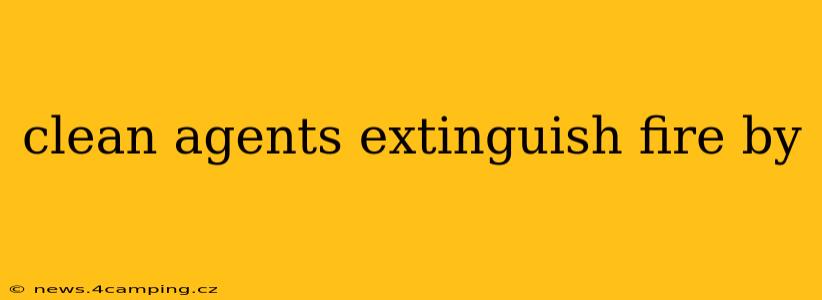Clean agents, also known as environmentally friendly fire suppressants, extinguish fires by interrupting the chemical chain reaction necessary for combustion. Unlike water or foam, which primarily cool the fire, clean agents work by targeting the fire's fuel-oxygen interaction, making it impossible for the fire to continue burning. This makes them particularly effective in protecting sensitive equipment and environments where water damage is unacceptable.
Here's a closer look at how they achieve this:
How Do Clean Agents Work?
Clean agents achieve fire suppression through several mechanisms, depending on the specific agent used. However, the core principle is always the same: interfering with the combustion process. This is often accomplished through one or more of the following:
-
Heat Absorption: Some clean agents absorb heat from the fire, reducing the temperature below the point where combustion can be sustained. This is a secondary effect, however, as their primary mechanism of action lies elsewhere.
-
Chemical Chain Breaking: This is the most crucial mechanism. Clean agents interfere with the free radical reactions that sustain combustion. Free radicals are highly reactive chemical species that perpetuate the fire's chain reaction. Clean agents effectively break these chains, halting the fire's propagation.
-
Oxygen Displacement: Certain clean agents can displace oxygen, reducing the concentration below the level needed to support combustion. This is often a contributing factor but rarely the sole mechanism.
What are the Different Types of Clean Agents?
Several types of clean agents exist, each with its own chemical properties and effectiveness against different types of fires. Common examples include:
-
Inert Gases: These gases, such as Argon, Nitrogen, and Carbon Dioxide, displace oxygen, thus preventing combustion. Carbon Dioxide, while effective, isn't strictly a "clean" agent due to its potential environmental impact in high concentrations.
-
Halogenated Compounds: These compounds contain halogens (fluorine, chlorine, bromine, or iodine) and were historically widely used. However, many halogenated agents are being phased out due to their ozone-depleting and global warming potentials. Examples include Halon 1301 (now largely banned) and other similar compounds.
-
Hydrofluorocarbons (HFCs): These are less harmful to the ozone layer than previous halogenated agents, but they are still potent greenhouse gases. They offer good fire suppression capabilities but are gradually being replaced by more environmentally friendly options.
-
Hydrofluoroolefins (HFOs): Considered the next generation of clean agents, HFOs have very low global warming potential and minimal impact on the ozone layer. They are becoming increasingly popular as a replacement for older, less environmentally friendly agents.
What are the Advantages of Using Clean Agents?
The primary advantages of clean agents over traditional extinguishing methods are:
-
Environmental Friendliness: Modern clean agents minimize damage to the ozone layer and have low global warming potential.
-
No Water Damage: This is crucial for protecting sensitive electronic equipment, documents, and valuable items.
-
Rapid Fire Suppression: Clean agents often extinguish fires faster than water or foam.
-
Minimal Residue: Clean agents leave minimal residue, reducing the need for extensive cleanup after a fire.
Are Clean Agents Safe for People?
While generally safe when used correctly, clean agents can pose risks at high concentrations. Some can cause asphyxiation by displacing oxygen. Proper ventilation is crucial after deployment, and safety guidelines must be followed diligently.
What are the Disadvantages of Clean Agents?
Despite their benefits, clean agents have some limitations:
-
Cost: Clean agents are often more expensive than traditional extinguishing agents like water.
-
Specific Applications: Certain clean agents may be less effective against specific types of fires (e.g., Class D fires involving combustible metals).
What are the common applications for clean agents?
Clean agents are frequently used to protect valuable assets and sensitive environments in:
- Data centers: Protecting servers and other crucial IT equipment.
- Museums and archives: Preserving irreplaceable artifacts and documents.
- Clean rooms: Maintaining the sterility of controlled environments.
- Aircraft: Protecting the cabin and avionics systems.
This detailed explanation should provide a comprehensive understanding of how clean agents extinguish fires and their various applications. Remember to always consult with fire safety professionals for specific recommendations and guidance related to your particular situation.
